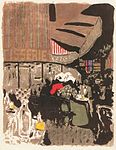Les Nabis
Les Nabis (från hebreiska "profeterna"), på svenska kallad Nabisgruppen, var en konstnärsgrupp som var verksam i Frankrike och ställde ut tillsammans från 1891 till 1900. Till gruppen hörde Édouard Vuillard, Pierre Bonnard, Maurice Denis, Paul Ranson, Ker-Xavier Roussel, Félix Vallotton, Paul Sérusier och Aristide Maillol.
Stilen var inspirerad av Paul Gauguins verk och hans förenkling av formerna till stora rena ytor, den så kallade syntetismen. Även Paul Cézanne inspirerade dem; Denis porträtterade Nabisgruppen framför en av Cézannes tavlor i Hommage à Cézanne 1900. Nabisgruppen hade en allmänt traditionalistisk och estetiserande inriktning med inslag av katolsk kyrklighet och målade gärna intima heminteriörer. Litografin var ett medium som passade gruppen särskilt bra och som kom till god användning i bokillustrationer och affischer. De ägnade sig även åt glasmåleri och teaterdekor. Gruppen kan ses som en föregångare till jugend.
Bilder
Édouard Vuillard – La Pâtisserie.
Félix Vallotton – La maitresse et la servante.
Paul Ranson – Paysage nabique.
Maurice Denis, Hommage à Cézanne (1900), Musée d'Orsay.
Referenser
- Nationalencyklopedin, Nabisgruppen. (hämtad 2023-03-18)
- Beckett, Wendy (1995). Bonniers stora bok om måleriets historia. Stockholm: Bonnier Alba i samarbete med National Gallery of Art, Washington, D.C. sid. 326–329. ISBN 91-34-51656-5
Media som används på denna webbplats
La Patisserie aus: Album Paysages et Interieurs, 5-farbige Lithografie, from: Paysages et intérieurs, Paris: A. Vollard [Publisher]
This painting rings out like a manifesto. Maurice Denis has assembled a group of friends, artists and critics, in the shop of the art dealer, Ambroise Vollard, to celebrate Paul Cézanne, who is represented by the still life on the easel. This painting, Fruit Bowl, Glass and Apples had belonged to Paul Gauguin, who is also evoked among the tutelary examples to whom Denis is paying homage. Effectively, a painting by Gauguin and another by Renoir can be made out in the background. Odilon Redon is also given pride of place: he is shown in the foreground on the far left and most of the figures are looking at him. He is listening to Paul Sérusier who is standing in front of him. From left to right, we can recognise Edouard Vuillard, the critic André Mellerio in a top hat, Vollard behind the easel, Maurice Denis, Paul Ranson, Ker-Xavier Roussel, Pierre Bonnard smoking a pipe, and lastly Marthe Denis, the painter's young wife. Part of the Nabi generation is gathered here in a composition which follows on from the homage paid by Fantin-Latour in several paintings, especially A Studio at Les Batignolles in the Musée d'Orsay. When Maurice Denis exhibited his work in Paris and Brussels in 1901, reactions were sometimes hostile. In his diary, the artist referred to it as "that painting, which still makes the public laugh". His friend, the writer André Gide, immediately offered to buy it. He did not part with it until 1928 when he gave it to the Musée du Luxembourg.







